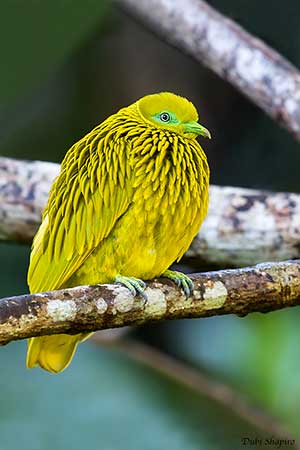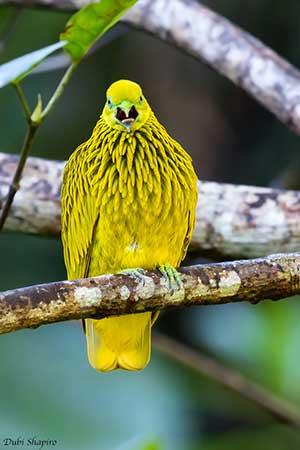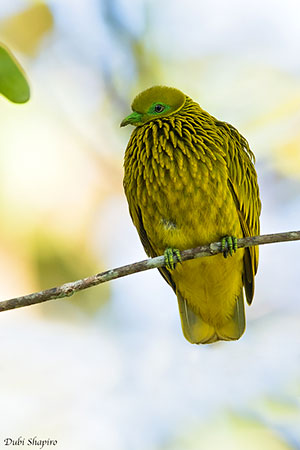
Fr: Ptilope jaune
Ang: Golden Fruit Dove
All: Goldfruchttaube
Esp: Tilopo Dorado
Ita: Tortora dorata
Nd: Gele Jufferduif
Sd: gyllenfruktduva
Photographer:
Dubi Shapiro
Dubi Shapiro Photo Galleries & Dubi Shapiro's Pictures on IBC
Text by Nicole Bouglouan
Sources:
HANDBOOK OF THE BIRDS OF THE WORLD vol 4 by Josep del Hoyo-Andrew Elliott-Jordi Sargatal - Lynx Edicions - ISBN: 8487334229
PIGEONS AND DOVES by David Gibbs, Eustace Barnes and John Cox - Pica Press Sussex - ISBN: 1873403607
Birds of Melanesia: Bismarcks, Solomons, Vanuatu and New Caledonia Par Guy Dutson – Editeur: Bloomsbury Publishing, 2011 – ISBN: 1408152460, 9781408152461
Wikipedia, the free encyclopaedia
Golden Fruit Dove
Ptilinopus luteovirens
Columbiformes Order – Columbidae Family
INTRODUCTION:
The Golden Fruit Dove is endemic to Fiji where it occurs on several islands of the archipelago.
This small dove feeds on fruits, berries and insects. It is mainly arboreal and often remains high in the canopy.
This species shows strong sexual dimorphism, with yellow male and green female. It nests in bushes in mature forests and secondary growths.
The Golden Fruit Dove is described as common and widespread throughout the range, and currently, the species is not globally threatened.

DESCRIPTION OF THE BIRD:
Biometrics:
Length: 20 cm
The Golden Fruit Dove adult male has greenish-yellow body feathers with olive edges involving streaked pattern. The feathers are elongated and cover a large part of the wings at rest. Wings and tail feathers are duller and greener than body plumage, and have yellow fringes.
On the underparts, the throat feathers are stiff and form scaled pattern. Neck and breast feathers are usually less elongated than those of the upperparts. The belly is orange-yellow. Underwing and undertail-coverts are bright yellow.
The head is olive-yellow.
The bill is green. The eyes are pale yellow, surrounded by extensive, bright green bare skin including much of the lores. Legs and feet are green, but tarsi are partly feathered.
The adult female has dark green plumage almost overall. Face and throat are more yellowish. The wings are darker green with yellow-edged feathers. The belly feathers are fringed pale yellow, but vent and undertail-coverts are yellow. The underwing is bright yellow.
The juvenile resembles adult female, but the yellow fringes of the flight-feathers are more conspicuous.
RANGE:
The Golden Fruit Dove is found on some islands such as Waya group, Viti Levu, Beqa, Ovalau and Gau in WC Fiji.
HABITAT:
The Golden Fruit Dove frequents the mature rainforest with tall trees and little undergrowth, but it is also found in more open forest, gallery forest and secondary growth. It is present from sea-level to 1,200 metres of elevation. It may sometimes occur close to towns and villages.
CALLS AND SONGS: SOUNDS BY XENO-CANTO
The Golden Fruit Dove male gives a sharp, short croak rapidly repeated, fairly similar to the bark of a distant dog “wu-wu-wu-wu-wu-wu”. This call is used as advertising call and usually given from high perch.
This species also utters low growling and snoring sounds. It is more often heard than seen.

BEHAVIOUR IN THE WILD:
The Golden Fruit Dove feeds primarily on small fruits, berries and insects. This species is mainly arboreal and remains often in the canopy. However, it also feeds in subcanopy and low bushes.
While foraging, it performs short flights from branch to branch. It is very agile and also hangs almost upside-down to reach fruits at the end of the branches.
From an observation, the female is known to glean insects from twigs and leaves.
Courtship displays and breeding biology are poorly known. The Golden Fruit Dove probably forms monogamous pair-bonds, at least for the season. Displays including advertising songs, pair-formation, selection of nest-site and nest-building are common at the beginning of the breeding season. Aggressive and defence behaviour is also observed.
The Golden Fruit Dove is resident in Fiji archipelago. It only moves between various feeding and foraging areas.
The flight includes rapid wingbeats interspersed with descending glides during which the wings produce a whistling sound. The flight is usually fast and direct. In flight, this dove appears plump, with broad, rounded wings and short tail.
REPRODUCTION OF THIS SPECIES:
A bird in breeding conditions was found in June-July on Viti Levu.
The Golden Fruit Dove builds a flimsy platform typical of Columbidae. It is made with twigs and vine tendrils. It is usually low, placed in dense bush or tangle of vine. The nest might be built by the female, unlike other Ptilinopus species. However, this behaviour was also observed in some other species of this family.
The female lays a single white egg.
PROTECTION / THREATS / STATUS:
The Golden Fruit Dove is described as common and widespread throughout its range, and especially on Viti Levu. But it is vulnerable to hunting pressure.
The population is apparently stable and the Golden Fruit Dove is currently evaluated as Least Concern.
